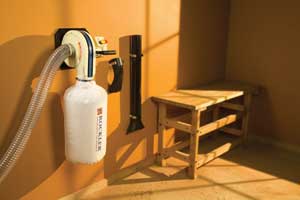
I have a basement workshop, and before I can buy any more woodworking tools my wife is insisting that I install a dust collection system. I currently have a table saw, router table and lathe and would like to add a thickness planer and possibly a jointer in the future. I don’t want to buy too small a system, so how do I figure out the size (i.e. the horsepower) of the dust collector I need?
Michael Dresdner: She’s right, you know. Dust collection is very important, both for your health and safety, and for the air that goes through the heating system in your home.
Unfortunately, size is more than simply a matter of how many, and which machines, are to be collected, though that is certainly part of the equation. You must also consider opening size, pipe length and diameter, number of corners, etc. What you really need is a way to design the whole system.
There are two convenient ways to go about that, one of which is upfront, while the other is cheaper in the long run. Companies like Oneida offer free dust collection system design services on their web site.
While a commercially designed system may be free, buying the recommended system may not be the cheapest way to accomplish your goals. Instead, you might prefer the learn-it-yourself approach. For that, I would suggest you pick up a copy of Sandor Nagyszalanczy’s book “Woodshop Dust Control” published by Taunton Press. It is an outstanding guide to everything you need to know about designing, buying, using, and maintaining dust control in your shop. I highly recommend it.
Rob Johnstone: Dust collection goes hand in hand with dust control. While that may seem a subtle point, it is the key to achieving the best results for your situation. If possible, dust creating activities should be segregated into an area that has physical boundaries & walls or even plastic sheeting & thus controlling where the dust is made. Point source collection or extraction occurs at the tool. This can be enhanced by shrouds and blade guards that include dust extraction ports, making vacuum systems more effective. Ambient dust filtration is the next line of defense. Air cleaners filter out the dust that has escaped the other control efforts. I agree with Michael that Sandor’s book is a must-read if you are serious about saw dust control.







